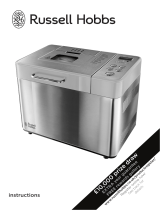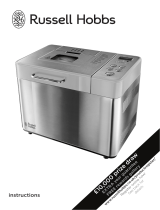IMPORTANT SAFETY INSTRUCTIONS
Before using the bread-maker, please read the following instructions carefully.
● The housing surfaces, steam vents and baking-tin heat up during operation and remain
hot for a short while after use: remember not to touch any hot parts of the unit. Be sure
to use an oven-cloth or suitable gloves when removing the bread.
● The bread-maker should only be connected to an earthed socket installed in accordance
with the regulations. Make sure that the supply voltage corresponds with the voltage
marked on the rating label.
● Always switch off the bread maker after use and remove the plug from the wall socket,
as well as
- in case of any malfunction during use,
- when removing the baking-tin,
- during cleaning.
● When removing the plug from the wall socket, never pull on the power cord; always grip
the plug itself. Do not allow the cord to hang free; the cord must be kept well away from
hot parts of the appliance.
● Before the appliance is used, the main body, including the power cord as well as any
attachment fitted, should be checked thoroughly for any defects. Should the appliance,
for instance, have been dropped onto a hard surface, it must no longer be used: even
invisible damage may have adverse effects on the operational safety of the appliance.
● The power cord should be regularly examined for any signs of damage. In the event of
such damage being found, the appliance must no longer be used.
● This appliance is not intended for use by any person (including children) with reduced
physical, sensory or mental capabilities, or lacking experience and knowledge, unless
they have been given supervision or instruction concerning the use of the appliance by a
person responsible for their safety.
● Children should be supervised to ensure that they do not play with the appliance.
● Ensure a minimum distance of 10 cm to walls or other objects. Do not position or
operate the appliance close to or underneath any hanging objects such as curtains or
other inflammable materials, and do not position any objects on top of the appliance
while it is in use.
● Always place the unit on a level, heat-resistant non-slip work surface.
● Do not allow the appliance or its power cord to touch hot surfaces or come into contact
with any heat sources (e.g. oven-plates or open flames).
● Do not operate the appliance unless the baking-tin with the ingredients has been placed
inside the unit.
● Do not expose the appliance to rain or moisture and do not operate the appliance
outdoors or on wet surfaces. Always ensure that it is well protected from water splashes.
Never immerse the plug, the power cord or the appliance itself in water.
● The appliance is not intended to be operated by means of an external timer or separate
remote-control system
● This appliance is intended for domestic use only and not for commercial applications.
● No responsibility will be accepted if damage results from improper use, or if these
instructions are not complied with.
● The use of any accessories other than those provided by the manufacturer may result in
damage to the appliance; there is also a possibility of severe personal injury.
● Do not touch any moving parts during operation. Do not put your fingers or hands inside
the unit, unless it is disconnected from the mains supply and has cooled down
completely.
19

















